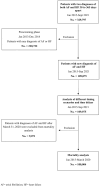All-Cause Mortality of Atrial Fibrillation and Heart Failure in the Same Patient: Does the Order Matter?
- PMID: 39136916
- PMCID: PMC11333397
- DOI: 10.1007/s40119-024-00378-1
All-Cause Mortality of Atrial Fibrillation and Heart Failure in the Same Patient: Does the Order Matter?
Abstract
Introduction: Atrial fibrillation (AF) and heart failure (HF) often coexist due to the common elements of the pathomechanism they share. The potential significance of the order these entities present in the same patient is ill-defined. Herein, we report our results from a nationwide database on the occurrence of various sequences AF and HF may present, the time delays between the two conditions and all-cause mortality associated with different scenarios.
Methods: Patients diagnosed with both AF and HF between 2015 and 2021 were enrolled from the Hungarian National Health Insurance Fund (NHIF) database. The order the two entities followed each other, and the time delay in between were registered. Median survival rates were calculated in AF → HF; HF → AF and simultaneous scenarios.
Results: A total of 109,075 patients were enrolled: 29,937 with AF → HF, 38,171 with HF → AF, and 40,967 diagnosed simultaneously. Time delays between AF → HF and HF → AF were 6 and 10 months, respectively. The median survival was 46 months in the AF → HF, 38 months in the HF → AF, and 21 months in the simultaneous group. Patients with HF → AF, and with simultaneous presentations had 5% and 16% greater mortality risk as compared to the AF → HF sequence, with hazard ratios (95% confidence intervals) of 0.95 (0.93-0.97) and 0.84 (0.82-0.85), respectively (P < 0.0001).
Conclusions: HF occurred significantly earlier after the diagnosis of AF than vice versa. Patients diagnosed simultaneously had the worst, while the AF → HF sequence had the best prognosis. These data should have implications for the intensification of monitoring and therapy in different scenarios.
Keywords: Atrial fibrillation; Heart failure; Mortality risk; Real-world evidence.
© 2024. The Author(s).
Conflict of interest statement
György Rokszin is employed by the company RxTarget Ltd. His contribution to this study analysis was financially compensated by the Hungarian Society of Cardiology. Béla Merkely reports grants or contracts from Medtronic and Boston Scientific, and personal fees from Biotronik and Abbott. Zoltán Járai reports payment or honoraria from Bayer, Boehringer, Pfizer, Richter Gedeon, Egis, Krka, Berlin Chemie – Menarini, Novo Nordisk, support for attending meetings from Egis, advisory board membership at Novo Nordisk, and board membership at the European Society of Hypertension, Hungarian Society of Hypertension, Hungarian Society of Cardiology. Tímea Papp, Zoltán Kiss, Dávid Becker, Andrási Jánosi and Zoltán Csanádi declare that the research was conducted in the absence of any commercial or financial relationships that could be construed as a potential conflict of interest.
Figures










Similar articles
-
Atrial fibrillation onset before heart failure or vice versa: what is worst? A nationwide register study.Europace. 2023 Feb 16;25(2):283-290. doi: 10.1093/europace/euac186. Europace. 2023. PMID: 36349557 Free PMC article.
-
Prognosis and treatment strategies for atrial fibrillation in heart failure with mildly reduced ejection fraction.Eur J Prev Cardiol. 2024 Aug 22;31(11):1372-1384. doi: 10.1093/eurjpc/zwae185. Eur J Prev Cardiol. 2024. PMID: 38825871
-
Characteristics, treatment, and outcomes of newly diagnosed atrial fibrillation patients with heart failure: GARFIELD-AF.ESC Heart Fail. 2021 Apr;8(2):1139-1149. doi: 10.1002/ehf2.13156. Epub 2021 Jan 12. ESC Heart Fail. 2021. PMID: 33434417 Free PMC article.
-
Epidemiology of Atrial Fibrillation and Heart Failure: A Growing and Important Problem.Cardiol Clin. 2019 May;37(2):119-129. doi: 10.1016/j.ccl.2019.01.001. Epub 2019 Feb 22. Cardiol Clin. 2019. PMID: 30926013 Review.
-
[Atrail fibrillation and heart failure: a complex relationship].G Ital Cardiol (Rome). 2006 Jan;7(1):40-9. G Ital Cardiol (Rome). 2006. PMID: 16528961 Review. Italian.
References
LinkOut - more resources
Full Text Sources
Research Materials
Miscellaneous

